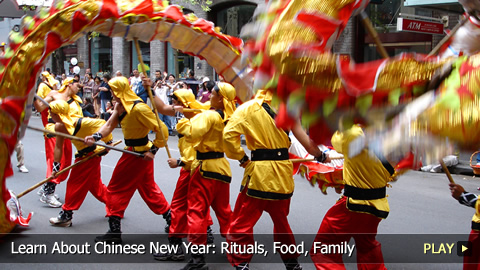Learn About Chinese New Year: Rituals, Food, Family

The Chinese Calendar
Chinese New Year begins on the first day of spring as determined by the luni-solar Chinese calendar. Also known as Lunar New Year or the Spring Festival, it ushers in a period of renewal.
Ancient Myths
Traditionally, it is believed that a mythical beast called Nian tormented villages by eating crops, farm animals and even children. Villagers thwarted the monster by leaving food on their doorsteps and by discovering his fear of the color red. The monster was ultimately captured, which left the villagers to celebrate.
Zodiac Signs
The Chinese calendar dates back to roughly the 14th century B.C.E., and the New Year is based on that calendar. To calculate the schedule, lunar phases, solar equinoxes and solstices, Chinese Zodiac signs and more are taken into account. Each year is ascribed the traits of one of the twelve zodiac animals: the rat, ox, tiger, rabbit, dragon, snake, horse, sheep, monkey, rooster, dog and pig.
Cleaning the Home
To get ready for the coming holiday, families thoroughly clean their homes as an offering to the gods, and as a way to cleanse the sins of the previous year.
Rituals
Citizens also give ritual sacrifices to the gods in the form of food and paper crafts. The importance of the color red is evident in the home’s decorations, and in the color of the envelopes used to present children with gifts of money.
Celebrations for Luck
Huge, elaborate fireworks and the loud drum beats of the dragon and lion dances ward off bad spirits and serve as a celebration. Most rituals associated with Chinese New Year bring good fortune to the home.
Family
Traditionally, family and the home are the main focus over the holidays, and work stops almost completely. For the year’s first days, tempers are kept in check and only kind words are used.
Food
Food is another part of the ritual: the New Year’s Eve reunion dinner is a multi-course feast that includes pork and chicken, as well as a number of other symbolic foods. Long noodles represent longevity, while round dumplings are eaten on the fifteenth and last day of celebrations in a depiction of that night’s full moon. Fish is also consumed at the reunion dinner as a representation of abundance, but it is left unfinished and the leftovers are kept overnight.
The Lantern Festival
Chinese New Year celebrations are officially ended by the Lantern Festival, where the sky is a sea of bright and colorful lanterns.
Evolution of Celebrations
Like most ancient traditions, celebrations have evolved. China switched to the Gregorian calendar in 1912, and by 1949 Communist Dictator Mao Zedong’s regime had outlawed traditional Chinese New Year celebrations.
Present-Day Holiday
However, festivities resumed in the 1990s, and grew exponentially. In the yearly chunyun, citizens travel home to celebrate with family in the world’s largest annual migration. A gala is also televised each year, which families sometimes watch together.
A Colorful Holiday
The colorful traditions of Chinese New Year spread across the world with local Chinese populations. With festive rituals and a sense of renewal, it’s no wonder this custom has lasted for centuries.
